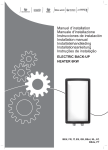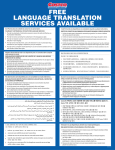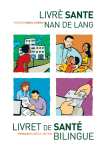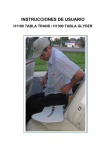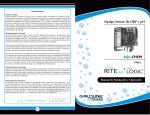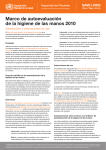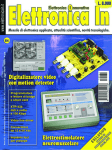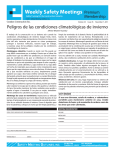Download Abril 2004 - Teach More/Love More
Transcript
Volume 3, Issue 6 • April 2004 d r e a d t o y o u r c h i l d re sing an n, h your child c ounts. So ug th l ea r n, l o w, r re g u l a l y and c ho r cto do sign al s , take them to a Calendar of Events .....................4 • Read with your child every day. • Keep using books in routines. • Relate books to your child’s experiences. • Provide crayons and paper for story writing and illustrating. • Encourage writing and drawing. • Let your child “tell you” the story, even if he or she can’t read the words yet. • Engage in imaginative and “pretend” play with your child. • Sing rhyming songs and “finger plays” with your child. Be sure your child sees you reading the newspaper, recipes, books and other reading materials. Show your child how reading plays an important role in your life. eir Participating Reach Out and Read Miami Sites .......................4 Be willing to read the same story over and over. Children love repetition. Read with your child every day. Keep using books in routines. Read at bedtime. Be willing to read the same story over and over again. Ask “What do you think will happen next?” Or, “What is that?” Relate books to your child’s experiences. Provide crayons and paper for story writing and illustrating. th • • • • • • • • o Learn to handle paper pages; turn back and forth in books to find favorite pictures; recite whole phrases, sometimes whole stories; associate words with pictures; read familiar books to self. 3 years and up Turn pages one at a time; listen to longer stories; retell a familiar story; understand what text is; move finger along text; begin to “write” their name and letters; begin to identify some letters of the alphabet; begin to sequence events in stories (what comes first, middle and last). tin m ro u e s , re What you can do to promote early literacy: • Find books that relate to your child’s experiences. • Follow your child’s cues. If your child seems tired or over-stimulated, provide some quiet, restful time. If your child seems alert and interested in playing and interacting, keep the stories coming. • Include books in daily routines, such as bedtimes. • Ask open-ended questions such as “What’s that?’’ and give your child time to answer and respond. Encourage your child to complete some sentences in the books, if he or she chooses. • Point to pictures in the book and name the objects to build your child’s vocabulary. t Art Corner: Goodnight Vincent .....................4 d Peaceful Homes: Learning Ways to Solve Problems ...................................3 spo n Car Seat Safety ..........................3 24-36 months the Bedtime Bottles .........................2 ive Your child may be able to: Turn board book pages easily, one at a time; carry a book around the house; name familiar pictures; fill in words with familiar stories; “read” to dolls or stuffed animals; recite parts of well-known, familiar stories. Safe Swimming ..........................2 an d s T hat’s ho Ask the Expert............................2 l y. Inside: i se Age 18-24 months ve ceed . Brought to you by Reach Out and Read Miami, affiliated with the Department of Pediatrics, Boston Medical Center, Boston University School of Medicine. Part Two of this series provides inforport early literacy skills so children mation about children’s developmental enter school prepared for success. milestones and suggestions for how Currently, through a partnership with parents of children18 months to 5 the University of Miami’s School of years can promote early literacy.This Medicine, 15 pediatric sites in Miamiinformation was compiled from the Dade are providing children’s books at Developmental Milestones of Early well-doctor visits as well as information Literacy Guide published by Scholastic about how parents can support their Publishers and distributed through our child’s literacy development. Reach Out and Read program, a Here is information for parents and national pediatric early literacy program, caregivers from the National Reach helping families and communities sup- Out and Read Center: o r c h i l d c a re w uc Ready to Learn: Give Your Child the Best Start (Part Two of a Series) you se em ,g Call 305-631-8111 to learn more © www.teachmorelovemore.org i l d re n gro with ch ng l e mome n t yo ery s i u spe nd w Ev OUR MISSION: To ensure that all children in Miami-Dade County have the community’s attention, commitment and resources--and, hence, the chance to develop intellectually, emotionally, socially and physically so that they are ready and eager to learn by the time they reach first grade. If you have questions about raising your child or being a parent, call: Teach More/Love More at 305-631-8111 Operated in English, Spanish and Creole 24 hours a day. Si ou ta renmen resevwa ti jounal sa a an kreyòl, rele (305) 631-8111. For more information, please call us at (305) 631-8111 or visit us at www.teachmorelovemore.org. Ask the Expert By Debbie Glasser, Ph.D., director of family support services at the Mailman Segal Institute for Early Childhood Studies at Nova Southeastern University and author of “Positive Parenting,” a weekly feature of The Miami Herald. Question: My 3-year-old son refuses to share. He thinks everything is “mine.” I don’t want him to be selfish. What can I do? Answer: Toddlers commonly think everything belongs to them.Young children tend to be naturally selfcentered and are still learning how to share.Your son’s behavior does not mean he is selfish. He can gradually learn how to share with others with your encouragement and support. Here are some suggestions: Be patient. Learning to share is an important goal of childhood, but a skill that takes time to master. Support his feelings. When your child says, “Mine,” let him know you understand his feelings.Then, gently remind him that others want to share, too. When he says, “My truck,” you can say, “Yes, that is your truck and it is very special to you. Now, Jamie wants a turn playing with it, and then she’ll give it back.” Be flexible and realistic. In every child’s life, a few items or toys may too personal or valuable to share. For example, your child may have a treasured bear or prized superhero cape that holds special meaning for him. Consider allowing your child to put a few special things away before a friend comes over.Then explain that everything else can be “sharing toys.” Be a role model. Share with others and point out sharing behaviors. For example, when your son wants to try on his father’s shoes, his father can say, “These are my shoes, and I will be happy to share them with you.” Practice. Among the best ways children can learn to share is by practicing these skills with friends. Arrange “play dates” in your home and supervise the children as they learn to take turns and share. When possible, introduce play activities that can be enjoyed together such as a group art project or playing “catch” with a ball. Show your son how much fun it can be to share and take turns with a friend. Encourage efforts and progress. Focus on your son’s positive behaviors. “Joey, I noticed that you and Trevor took turns with your cars.You’re really learning how to share!” If you have questions or concerns about your son’s behavior, talk with his health care provider. In time, and with your support, your son gradually will learn how to share with others. x Safe Swimming By Lee M. Sanders, MD, MPH from the Department of Pediatrics at the University of Miami / Jackson Memorial Hospital. As summer nears and the waters warm, children in South Florida will be spending more of their time in and around water. This can be an important and enjoyable part of growing up in the Sunshine State. Unfortunately, drowning remains the leading cause of death for children 1 to 4 years in Florida. While many local programs offer swimming lessons to children of all ages, these lessons alone cannot prevent drowning. All young children in and around water should receive constant, close supervision by an adult. Infant and preschool programs have been developed by the American Red Cross and the YMCA to provide enjoyment for parents and children. But they are not designed to teach children to become accomplished swimmers or to survive on their own in the water. Having children begin swimming lessons at an earlier age does not mean they will be better swimmers than those taking lessons at a later age. The American Academy of Pediatrics makes these recommendations for teaching young children to swim safely: 1. Children are not developmentally ready for formal swimming lessons until after their fourth birthday. 2. Swimming lessons for infants and toddlers should not be promoted as a way to decrease the risk of drowning. 3. Parents should not feel secure that their child is safe in water or safe from drowning after participation in such programs. 4. Whenever infants and toddlers are in or around water, an adult should be within an arm's length, providing "touch supervision." For children over 4 years, contact the Miami-Dade Parks’ Learn to Swim Program (305-755-7800) for low-cost, certified lessons in your area. z Bedtime Bottles By Sheah Rarback M.S., R.D., from the Mailman Center for Child Development at the University of Miami. Between the ages of 1 and 2, babies who have been drinking from bottles may be giving up their bedtime bottle of milk.This is a good idea because letting milk remain on the teeth at bedtime can contribute to cavities in the upper front teeth. Drinking juice from a bottle at bedtime also can contribute to cavities. Some toddlers enjoy having something to eat or drink just before going to sleep. If they do, help them brush their teeth prior to going to bed to promote good habits and keep their teeth healthy. An average 8-ounce bottle of milk provides 160 calories. Toddlers usually adjust to calorie changes in their food intake by making up for it at other times. A toddler who stops drinking a bedtime bottle might eat a little more at breakfast, lunch, dinner and snacks and naturally make up the lost calories. If your family’s health care provider recommends that your child maintain a high calorie diet, or he or she has concerns about eliminating the bedtime feeding, ask for appropriate recommendations regarding your child’s nutritional needs.Your child’s physician also can provide a referral to a pediatric dietitian if additional support is indicated. o Car Seat Safety By Hilda De Gaetano, D.O., FAAP, FACOP Motor vehicle crashes are the leading cause of death in children between 1 and 14 years old. Up to 80% of child safety seats are used incorrectly. Child safety seats are crucial for the well being of children who ride in motor vehicles. Many parents and caregivers are unaware of these guidelines for proper car seat safety: 1. Infants should be rear facing until they a one year old AND weigh 20 pounds. Infants should be placed in the center of the back seat in an approved car seat. Infants weighing 20 pounds at 8 months of age should still remain rear facing until the first birthday. Infants weighing 16 pounds at a year of age should remain rear facing until reaching 20 pounds. The rear facing position provides the most protection for your infant’s still-developing head and neck muscles. 2. Once your baby reaches his first birthday and weighs at least 20 pounds, the safety-approved seat should be forward facing and placed in the center of the back seat of your car. Note the size and weight recommendations for your car seat. Some seats are approved from birth to 40 pounds and can be converted from a rear to a forward facing seat. Others are only designed for infant use. Check the car seat manual. Once the child reaches a certain height, your seat may need to be changed. 3. Once your child weighs over 40 pounds, you can switch the car seat to a booster seat with a high back. Some seats have a removable harness system that can help ensure a proper fit for the adult shoulder-lap seat belt as your child grows. Many parents don’t realize that children need to be secured in a safe restraining device in the car until they weigh more than 80 pounds and over 58 inches tall. Until your child reaches this size, that child is still too small to use the adult seat belt, and needs a safety device that is appropriate for age and size. Adults need to be are aware of how to install and use car seats properly.The owner’s manual provided by the car seat manufacturer will describe proper installation instructions and other important safety information. Many places in your community offer free car seat inspections and safety tips. Contact your local police or fire department for times and locations. w Peaceful Homes: Learning Ways to Solve Problems Brought to you by Diane Golden of the Peace Education Foundation. Learning to solve problems is a skill all children can learn. However, young children do not have the advanced language skills or emotional maturity to solve problems on their own. With your guidance, your child gradually can learn these skills as he grows. You can introduce the problem-solving process as early as the toddler years. Here’s how: 1. Begin by clearly identifying the problem. Use a respectful “I-message” by saying how you feel without blaming or discouraging your child. For example, “I feel upset when the toys are all over the floor. Someone could trip on them and get hurt.” 2. Ask your child to help you think of possible solutions to solve this problem. Remember, he is still learning and needs your help. Have two or three possible solutions in mind and help your child choose one. In time, he may begin to generate solutions independently. You might say, “What can we do about these toys on the floor?”Your child might answer, “I don’t know” or offer unrealistic suggestions such as, “Let’s vacuum them up!”You could respond, “Vacuuming toys would be funny, but that wouldn’t work because vacuums aren’t for toys. What other ideas do you have?” If your child still needs help, you could say, “You could pick them up by yourself. Or you could ask someone for help. Which do you choose?” 3. Help your child choose a realistic solution. If he says, “I don’t want to clean up,” you can respond, “That’s not a choice.The toys do need to be put away. Would you like to clean up or can I help?” 4. Put the plan into action. For example, if your child asks for help say, “Okay, let’s pick up these toys together.” Break down the task into smaller steps so he can feel successful. For example, “Should we pick up the trucks first or the Legos? You choose.” 5. Evaluate how the solution worked.You could say, “It worked! The toys were put away when we worked together.” If it did not work, say so. “That idea didn’t work, what else could we try?” Then, go back to Step 2. 6. Show your child how he helped solve the problem. “Picking up the toys together really worked. Asking someone else for help is one good way to solve a problem.” One of the most important ways your child will learn how to solve problems is by watching you. Serve as a positive role model when faced with problems and challenges in your life. o HELP? If you have a child who you suspect may have a developmental delay or disability, please consult your child’s health care provider or contact: •Ages 0 to 3: Early Intervention Program North: (305) 243-5600, Visit your local library for books, activities and ideas to encourage your child’s literacy. To find a library near you, call 305-275-2665 or log on to www.mdpls.org. South: (786) 268-2611 •Ages 3 to 5: FDLRS/ Miami-Dade Public Schools (305)274-3501 Art Corner: Goodnight Vincent This activity brought to you by Kristin Read of the Miami Children Museum’s Early Childhood Center. This month, introduce your child to the wonderful world of fine art. Here is a bedtime activity that you and your child can enjoy together. It is a unique way to introduce your child to a well-known artist and help build language skills, as well. First, read the book “Goodnight Moon,” by Margaret Wise Brown, with your child.This book follows a mother and child as they say “Good night” to all of the objects in the child’s bedroom including the telephone, red balloon and a picture on the wall. Extend this reading activity by naming and saying “Good night” to all of the objects in your child’s bedroom.Toddlers and preschoolers might enjoy describing each item’s color, size, and more. For example, “Good night, big blue teddy bear!” Then show your child a copy of Vincent Van Gogh’s painting, “Vincent's Bedroom in Arles.” Visit your local library, the Miami Children's Museum Parent/Teacher Resource Center or the Internet for a copy of this painting. As you look at the painting together, have fun naming the items from this artist’s bedroom. Children and adults can enjoy this activity together, and can become a favorite and creative way to end the day. w Be a part of our Newsletter Send in: Photos, question or helpful tips. Photos will be included in each issue. These photos personify our readership and do not imply or suggest any particular family styles or situations. • Questions will be answered by local experts. MAIL TO: The Early Childhood Initiative Foundation 3250 SW Third Ave., Miami, Fla. 33129 Participating Reach Out and Read Miami Sites Liberty City Health Center (305-835-2200) UM Pediatric Infectious Disease & Immunology (305-243-4445) Jefferson Reeves Sr. Health Center (305-577-0093) Doris Ison Health Center (305-252-4852) Miami Children’s Hospital Continuing Care Center (305-669-6505) MLK Jr. Clinica Campesina (305-242-6017) UMDC Pediatric Associates (305-243-7570) Guardian Health Center (305-438-9461) Published through support from: The Early Childhood Initiative Foundation (305-646-7229) and United Way Success By 6 at (305-860-3000). These two organizations work closely with the Miami-Dade School Readiness Coalition, responsible for subsidized child care programs. The coalition chief executive officer is Paula Bender (305-646-7225). Miami Hope Center (305-329-3021) Editor: Ana de Aguiar (305-646-7230) Kid Care Pediatrics (305-821-1600) Newsletter Consultant: Dr. Debbie Glasser Calendar of Events You’re invited. Free Friday Nights at the Miami Children's Museum April 16 • 6:30 p.m. – 8:30 p.m. Join us with your family the third Friday of each month for free and enjoy activities in the Miami Children’s Museum, including our new exhibit, Brazil. Take a stroll down Rio de Janiero’s famous Avenida Atlantica, create your own Carnival parade and explore an Amazon village. The exhibit’s a cultural, architectural and ecological environment invites visitors to engage in hands-on activities including dance, music, crafts and celebrations. x Want to subscribe to this newsletter for free? ¿Desea una suscripción gratuita para este boletín? Send this to / Envie esto a: The Early Childhood Initiative Foundation, 3250 SW Third Ave., Miami, Fla. 33129 or call 305-631-8111 Name / Nombre __________________________ Phone / Teléfono__________________ Address / Dirección ________________________________________________________ I prefer / Prefiero: ❑ Spanish ❑ English ❑ Creole Volumen 3, Número 6 Abril 04 mento que usted p da mo asa co abrácelo, señálele deb Ca n su h cuentos, eres e l a ijo, cue é l par nta. Por eso, cántele y a re ali za Calendario de Eventos ..........4 crece, apre ijo amente y eriódic esc op c oj i éd m Aprende a pasar las páginas de papel: va de un lado a otro del libro para buscar los dibujos que más le gustan, repite frases completas, a veces, el cuento completo; asocia palabras con dibujos, lee para sí libros conocidos. • • • • • • • • A Partir de los 3 años Pasa las hojas una a una, escucha cuentos más largos; repite una historia familiar; comprende lo que es el texto; mueve los dedos a lo largo del renglón; comienza a “escribir” su nombre y las letras; empieza a identificar algunas letras del alfabeto; comienza a comprender la secuencia de los cuentos (lo que viene primero, después y al final). • Lea con el niño todos los días. • Siga usando libros en las rutinas. • Relacione los libros con las experiencias de su hijo. • Proporciónele papel y lápices para que escriba o ilustre los cuentos. • Anímelo a escribir y a dibujar. • Deje que su hijo “le cuente” el cuento, incluso si todavía no sabe leer. • Participe con el niño en juegos inventados e imaginativos. • Cántele canciones infantiles y mueva las manos representando el significado de las palabras de la canción. Haga que el niño le vea leyendo el periódico, recetas, libros y otros materiales de lectura. Enséñele que la lectura forma una parte importante de su vida. Asientos seguros para el auto ....................................3 Participating Reach Out and Read Miami Sites .......................4 amiento, llé v mport e los u co al es sd ale 24-36 meses El biberón de la noche...........2 como su h Lo que se puede hacer para promover el aprendizaje: Nadar sin Peligro ....................2 í es As El niño debe ser capaz de: Pasar fácilmente, una por una, las hojas de un libro de cartón; andar con el libro por toda la casa, nombrar dibujos de objetos familiares, intercalar palabras en cuentos familiares, “leerle” a las muñecas o peluches; recitar partes de cuentos que conoce bien. Pregúntele a la Experta .........2 Buenas noches, Vincent ........4 Información para padres y personas que cuidan niños del Centro National Reach Out and Read: Edad 18-24 meses Contenido: Hogares apacibles: Aprender a resolver problemas ............3 familias y comunidades a apoyar dicha habilidad, de modo que los niños entren en la escuela preparados para tener éxito en sus estudios. Actualmente, 15 sitios pediátricos en Miami-Dade, en colaboración con la Escuela de Medicina de la Universidad de Miami, están ofreciendo libros infantiles en las visitas de rutina al pediatra como medio de información a los padres sobre cómo pueden ayudar al proceso de aprendizaje de sus hijos. va a cuida r. La Parte Dos de esta serie brinda información sobre las etapas de desarrollo de los niños, así como sugerencias para los padres de niños entre 18 meses y 5 años sobre cómo promover tempranamente el aprendizaje de la lectura y la escritura. Esta información fue recopilada en la Guía de las Etapas de Desarrollo del Aprendizaje Adelantado de la Lectura y la Escritura, publicada por Scholastic Publishers y distribuída por nuestro programa Reach Out and Read, un programa pediátrico nacional sobre la instrucción precóz, que ayuda a las lo se ue Por Reach Out and Read Miami, afiliado al Departamento de Pediatría, de Boston Medical Center de la Escuela de Medicina de la Universidad de Boston. , ama nde riunfa. yt Listo para aprender: Proporciónele a su Hijo el Mejor Comienzo (Parte Dos de una Serie) ien a la persona yb u q am a rutina, atienda a o un l a ss om eñ sc rlo Para más información llame al 305-631-8111 o visítenos en ensenemasamemas.org • Buscar libros que relaten las experiencias de su niño. • Actuar de acuerdo con los intereses del niño: si parece cansado o sobre-estimulado, dejarle descansar. Si parece alerta e interesado en jugar e interactuar, continuar con la lectura. • Los libros deben ser parte de la rutina diaria, como a la hora de dormir. • Haga preguntas de respuesta libre, tales como ¿Qué es esto? y dele tiempo para responder. Anímelo a terminar algunas oraciones en el libro, si así lo prefiere. • Señale los dibujos del libro y nombre los objetos para ampliar el vocabulario del niño. Dispóngase a leer el mismo cuento una y otra vez. A los niños les encanta la repetición. Lea con su hijo todos los días. Siga usando los libros en las rutinas. Lea a la hora de ir a la cama. Dispóngase a leer el mismo cuento una y otra vez. Pregúntele: “¿Qué piensas que va a pasar después?” o “¿Qué es eso?. Relacione los libros con las experiencias de su hijo. Proporciónele papel y lápiz para que escriba o ilustre el cuento. NUESTRA MISIÓN: Asegurar que todos los niños del Condado MiamiDade cuenten con la atención, el compromiso y los recursos de la comunidad y, por ende, con la oportunidad de desarrollarse intelectual, emocional, social y físicamente de modo que cuando llegue el momento de ir al primer grado, estén listos y deseosos de aprender. Si tiene alguna pregunta sobre cómo criar a su hijo o cómo ser un buen padre, llame a Enseñe Más/ Ame Más, al 305-631-8111. Esta organización opera en inglés, español y créole, las 24 horas. Si ou ta renmen resevwa ti jounal sa a an kreyòl, rele (305) 631-8111 Para más información, por favor llámenos al 305-631-8111 o visítenos en http://www.ensenemasamemas.org Pregúntele a la Experta La Dra. Debbie Glasser es la directora de los servicios de apoyo a la familia en el Instituto Mailman Segal para Estudios sobre la Primera Infancia en Nova Southeastern University. Además, escribe semanalmente la columna “Positive Parenting” en The Miami Herald. Pregunta: Mi hijo de 3 años no quiere compartir sus cosas. Piensa que todo “es mío.” No quiero que sea egoísta. ¿Qué puedo hacer? Respuesta: Los parvulitos piensan que todo les pertenece. Los niños pequeños tienden a ser naturalmente egocéntricos, y todavía tienen que aprender a compartir. La conducta de su hijo no significa que él sea egoísta. Si usted lo estimula y lo ayuda, él va a aprender gradualmente a compartir con los demás. Aquí le hago algunas sugerencias: Tenga paciencia. Aprender a compartir es una meta importante de la niñez, pero es una capacidad que toma tiempo llegar a dominar. Comprenda sus sentimientos. Cuando su hijo dice “mío”, dígale que usted entiende lo que siente. Entonces, amablemente, recuérdele que los demás quieren compartir también. Cuando el dice “mi camión”, usted puede decirle, “Sí, es tu camión, y tú lo quieres mucho. Ahora Juanito quiere jugar un rato con él, y después te lo va a devolver”. Sea flexible y realista. Para todos los niños, algunos objetos o juguetes pueden ser muy valiosos y personales como para compartirlos. Por ejemplo, su hijo puede tener un osito favorito o una capa de súper-héroe que tiene un significado especial para él. Considere permitirle a su hijo guardar algunas cosas especiales antes de que llegue su amigo. Entonces explíquele que todos los demás juguetes son “para compartir”. Dé el ejemplo. Comparta con los demás y haga notar esa conducta. Por ejemplo, cuando su hijo quiera ponerse los zapatos de su padre, el padre puede decir, “Esos son mis zapatos, y me encanta compartirlos contigo.” Practique. Practicar esa conducta con los amigos es una de las mejores formas en que los niños pueden aprender a compartir. Señale fechas para que otros niños vengan a jugar a su casa y supervise la forma en que ellos aprenden a jugar por turnos y a compartir. Cuando sea posible, enséñeles juegos que pueden disfrutar juntos, tales como hacer un proyecto de arte, o jugar con la pelota. Enséñele a su hijo cuán divertido puede ser compartir y esperar su turno para jugar con los amigos. Celebre los esfuerzos y el progreso. Preste atención a la conducta positiva del niño. “Pablito, he notado que tú y Carlos estuvieron jugando con tus carritos. ¡Estás aprendiendo muy bien a compartir!” Si tiene alguna pregunta o preocupación sobre la conducta de su hijo, hable con el pediatra del niño. Con el tiempo y con su ayuda, el niño va a aprender gradualmente a compartir con los demás. x Nadar sin Peligro Por Lee M. Sanders, MD, MPH del Departamento de Pediatría de la Universidad de Miami/Jackson Memorial Hospital. Según se acerca el verano y se entibian las aguas, los niños del Sur de la Florida pasarán más tiempo en – y alrededor – del agua. Esto puede ser una parte importante y satisfactoria de criarse en el Estado del Sol. Lamentablemente, la muerte por ahogamiento es la causa número uno en la Florida, para los niños de entre 1 y 4 años. Aunque muchos programas locales ofrecen clases de natación para niños de todas las edades, esas lecciones por sí solas no evitan que el niño se ahogue.Todos los niños pequeños que estén en – y alrededor – del agua deben estar constantemente supervisados de cerca por un adulto. La Cruz Roja Americana y YMCA han desarrollado programas para bebés y preescolares para disfrute de los padres y los niños. Pero dichos programas no están diseñados para enseñar a los niños a ser expertos nadadores ni para sobrevivir, por sí solos, cuando están en el agua. El hecho de que los niños tomen clases de natación desde muy corta edad no significa que van a ser mejores nadadores que los que las tomaron más tarde. La Academia Americana de Pediatría hace las siguientes recomendaciones para enseñar a los niños pequeños a nadar sin peligro: 1. Los niños no están completamente desarrollados para tomar clases formales de natación hasta los cuatro años. 2. Las clases de natación para bebés y parvulitos no deben promocionarse como una forma de disminuir el riesgo de que el niño se ahogue. 3. Los padres no deben sentirse seguros de que su hijo no tiene peligro en el agua porque ha participado en dichos programas. 4. Siempre que un bebé o un parvulito esté en – o alrededor – del agua, un adulto debe “supervisarlo a la distancia del alcance de su brazo”. Para niños mayores de 4 años, llame al Programa Aprender a Nadar del departamento de Parques de Miami-Dade, al (305-755-7800), para solicitar clases certificadas y de bajo costo en su área. z El biberón de la noche Por Sheah Rarback M.S., R.D., del Centro Mailman para el Desarrollo del Niño de la Universidad de Miami. Entre los doce meses y los 2 años, los bebés que han estado tomando en biberón pueden abandonar la toma de leche de la noche. Es una buena idea, porque dejar leche en la boca del bebé durante la noche puede contribuir a la formación de caries en los dientes centrales superiores. Lo mismo ocurre si a la hora de dormir toma jugo de frutas. A algunos parvulitos les gusta comer o beber algo antes de irse a dormir. Si ese es el caso, ayúdelos a cepillarse los dientes antes de acostarse para inculcarles buenos hábitos y cuidar la salud de sus dientes. Un biberón de 8 onzas proporciona 160 calorías. Los parvulitos generalmente ajustan los cambios calóricos en su alimentación comiendo más en otro momento. Es posible que un parvulito que deja de tomar leche a la hora de acostarse coma un poquito más en el siguiente desayuno, almuerzo, comida o merienda y habrá reparado de modo natural las calorías perdidas. Si su pediatra le recomienda que el niño mantenga una dieta alta en calorías, o si le preocupa eliminar la toma de la noche, pídale recomendaciones sobre las necesidades nutricionales de su hijo. El pediatra del niño también puede remitirlo a un dietista pediátrico si se indica alguna ayuda adicional. o Asientos seguros para el auto Por Hilda De Gaetano, D.O., FAAP, FACOP Los accidentes de tránsito son la causa principal de muerte en los niños entre los 12 meses y los 14 años. Hasta el 80% de los asientos de seguridad para los niños se usan incorrectamente. Esos asientos especiales son importantísimos para el bienestar de los niños que viajan en vehículos de motor. Muchos padres y otras personas que cuidan a los niños no siguen las siguientes reglas de seguridad: 1. Los niños deben ir mirando hacia atrás hasta que tengan un año de edad Y pesen 20 libras. Debe ir en el centro del asiento trasero en una silla que reúna l os requisitos de seguridad. Aunque un bebé pese 20 libras a los 8 meses, deberá ir mirando hacia atrás hasta que cumpla el año. Los que al año de edad pesen solamente 16 libras, también deberán ir mirando hacia atrás hasta que alcancen las 20 libras. Esta posición le da la mayor protección a su bebé, que todavía está desarrollando los músculos de la cabeza y el cuello. 2. Cuando el bebé ya tiene un año y pesa por lo menos 20 libras, el asiento de seguridad aprobado debe colocarse mirando hacia delante, en el centro del asiento trasero de su auto. Tenga en cuenta las recomendaciones de tamaño y peso para su auto. Algunas sillitas están aprobadas para que la usen los niños desde el recién nacido hasta las 40 libras, y se pueden colocar lo mismo mirando hacia atrás que hacia delante. Otras han sido diseñadas sólo para bebés. Lea el manual. Cuando el niño llega a cierta estatura, tiene que cambiar el asiento. 3. Cuando el niño pesa más de 40 libras, puede cambiar el asiento para uno que es elevado y que tiene un respaldar alto.Algunos asientos tienen un sistema de correas removibles que le permite utilizar las correas del hombro y del bajo vientre del automóvil cuando el niño va creciendo. Muchos padres no se dan cuenta de que tienen que asegurar a los niños con un mecanismo que los sujete en el auto hasta que pesen más de 80 libras y midan más de 58 pulgadas. Hasta que su hijo llegue a esas medidas, se considera que es todavía demasiado pequeño para usar las correas de adulto, y que necesita un mecanismo de seguridad apropiado a su edad y tamaño. Los adultos tienen que estar pendientes de cómo instalar y usar los asientos debidamente. El manual del usuario que provee el fabricante trae las instrucciones para instalarlos correctamente, además de otras medidas de seguridad. Muchos lugares en su comunidad le ofrecen gratis inspección del asiento y consejos de seguridad. Póngase en contacto con el departamento de policía o de bomberos de su localidad para que le informen de direcciones y horarios en que le pueden atender. w Hogares apacibles: Aprender a resolver problemas Por Diane Golden, de Peace Education Foundation. Los niños pueden aprender a resolver problemas. Sin embargo, los pequeños no tienen todavía el vocabulario suficiente ni la madurez emocional para hacerlo. Con su ayuda, su hijo puede aprender poco a poco estas habilidades. Desde que es un parvulito, usted puede enseñarle el proceso de resolver problemas. He aquí cómo: 1. Comience identificando claramente el problema. El mensaje debe ser respetuoso, diciéndole cómo usted se siente, sin reprocharle ni desaprobarlo. Por ejemplo, “Me molesta que los juguetes estén regados por todo el suelo. Alguien puede tropezar y hacerse daño.” 2. Pídale que le ayude a pensar en posibles soluciones para ese problema. Recuerde, él está aprendiendo todavía y necesita su ayuda. Piense en dos o tres soluciones posibles y ayúdelo a escoger una. Con el tiempo, él puede comenzar a encontrar soluciones por sí mismo. Usted puede decirle, “¿Qué podemos hacer con esos juguetes que están en el suelo? El puede contestarle “Yo no sé” u ofrecerle una solución que no es realista, como “Vamos a pasar la aspiradora.” Entonces usted puede decirle, “Pasar la aspiradora puede ser divertido, pero no va a funcionar porque la aspiradora no es para juguetes. ¿Qué otra cosa se te ocurre? Si todavía el niño necesita ayuda, usted puede decir, “Recógelos tú mismo. O puedes pedirle a alguien que te ayude. ¿Qué prefieres?” 3. Ayude al niño a escoger una solución realista. Si él le dice “No quiero recogerlos”, usted puede responder. “Eso no es una elección. Hay que quitar los juguetes de en medio. ¿Quieres recogerlos tú o quieres que te ayude?” 4. Ponga el plan en acción. Por ejemplo. Si el niño le pide ayuda, dígale, “Está bien, vamos a recogerlos juntos.” Divida la tarea en pequeños pasos, de manera que él sienta que está haciéndolo bien. Por ejemplo, “¿Qué recogemos primero, los camiones o los Legos? Tú escoges.” 5. Evalúe cómo funcionó la solución. Usted puede decir, “¡Qué bien! Juntos pudimos recoger los juguetes.” Y si no funcionó, dígale: “Esa idea no funcionó, ¿qué otra cosa podemos hacer?” Entonces, vuelva al paso 2. 6. Muéstrele cómo él ayudó a resolver el problema. “Recoger juntos los juguetes sí funcionó. Pedir ayuda a alguien es una buena forma de resolver un problema.” Una de las formas en que mejor aprende un niño a resolver un problema es fijándose en usted. Sirva como un ejemplo positivo cuando usted confronte problemas y retos en su vida. o ¿ AYUDA? Si usted piensa que su hijo pudiera tener un retraso en el desarrollo o alguna minusvalía, consulte con el proveedor de salud del niño o póngase en contacto con:• Para niños de 0 a 3 años: Early Intervention Visite su biblioteca local para encontrar los libros, actividades y otras ideas que ayuden a su niño a aprender a leer y escribir. Para encontrar una biblioteca cerca de Ud., llame al 305-275-2665 o conectese al www.mdpls.org. Program Norte: (305) 243-5600 • Sur: (786) 268-2611•Para niños de 3 a 5 años: FDLRS/Miami-Dade Public Schools (305) 274-3501 Buenas noches, Vincent Por Kristin Read, del Centro para la Primera Infancia del Museo de los Niños de Miami. Este mes, preséntele a su hijo el maravilloso mundo de las bellas artes. A continuación le propongo una actividad para la hora de ir a dormir que tanto el niño como usted van a disfrutar. Es una forma muy particular de presentarle a su hijo a un artista muy conocido, y de ayudarle a mejorar su expresión oral también. Primero que todo, léale el libro “Buenas noches, Luna” de Margaret Wise Brown. Este libro lleva a la madre y al hijo, cada vez que dicen “Buenas noches” a todos los objetos que hay en la habitación del niño, incluyendo el teléfono, el globo de color rojo y el cuadro en la pared. Amplíe esta actividad de lectura nombrando todos los objetos que hay en la habitación y diciéndoles “Buenas noches.” Los parvulitos y los preescolares disfrutan describiendo el color, el tamaño y otras características de cada uno. Por ejemplo: “Buenas noches, osito grande y azul.” Después, enséñele al niño una copia del cuadro de Vincent Van Gogh, “Vincent's Bedroom in Arles” (La habitación de Vincent en Arlés).Vayan a la biblioteca, al Centro de Recursos para los Padres y Maestros del Museo de los Niños de Miami, o busque una copia de este cuadro en Internet. Cuando miren juntos el cuadro, nombren los objetos que hay en la habitación del artista. Niños y adultos pueden disfrutar de esta actividad juntos, que puede convertirse en una forma creativa de terminar el día. w Participating Reach Out and Read Miami Sites Liberty City Health Center (305-835-2200) UM Pediatric Infectious Disease & Immunology (305-243-4445) Jefferson Reeves Sr. Health Center (305-577-0093) Doris Ison Health Center (305-252-4852) Miami Children’s Hospital Continuing Care Center (305-669-6505) MLK Jr. Clinica Campesina (305-242-6017) UMDC Pediatric Associates (305-243-7570) Guardian Health Center (305-438-9461) Miami Hope Center (305-329-3021) Forme Parte Del Boletín Envíenos fotos, preguntas o ideas provechosas. Incluiremos fotos en cada boletín. Esas fotos personifican a nuestros lectores y no sugieren estilos de familias o situaciones específicas. • Expertos locales contestarán las preguntas. Envíelas a: The Early Childhood Initiative Foundation 3250 SW Third Ave., Miami, Fla. 33129 Publicación patrocinada por: The Early Childhood Initiative Foundation (305-646-7229) y United Way Success By 6 (305-860-3000). Estas organizaciones colaboran con Miami-Dade School Readiness Coalition, la organización responsible de los programas infantiles subsidiados. La directora ejecutiva de la coalición es Paula Bender (305-646-7225). Directora del boletín: Ana de Aguiar (305-646-7230) Consultora del boletín: Dra. Debbie Glasser Kid Care Pediatrics (305-821-1600) 3250 SW Third Ave. Miami, Fla. 33129 Calendario de Eventos Están invitados a asistir, gratis, al Miami Children's Museum viernes, abril 16 de 6:30 p.m. a 8:30 p.m. Venga con su familia el tercer viernes de cada mes para disfrutar, gratis, de las actividades que ofrece el Museo de los Niños de Miami (Miami Children's Museum), incluyendo la nueva exhibición llamada Brasil. Den un paseo por la famosa Avenida Atlántica de Río de Janeiro, hagan su propio desfile de carnaval y visiten un pueblo del Amazonas. La exhibición, que representa un entorno cultural, arquitectónico y ecológico, invita a los visitantes a participar activamente en actividades que incluyen danza, música, artesanía y celebraciones. x NON-PROFIT ORG. U.S. POSTAGE PAID MIAMI, FL PERMIT #5665








